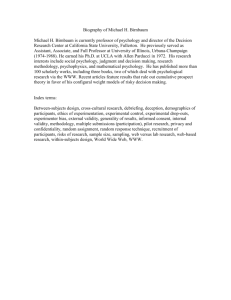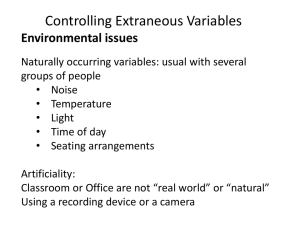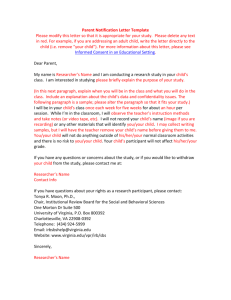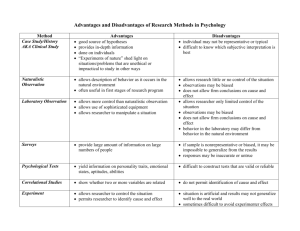Research Strategies: Descriptive, Correlational, Experimental
advertisement
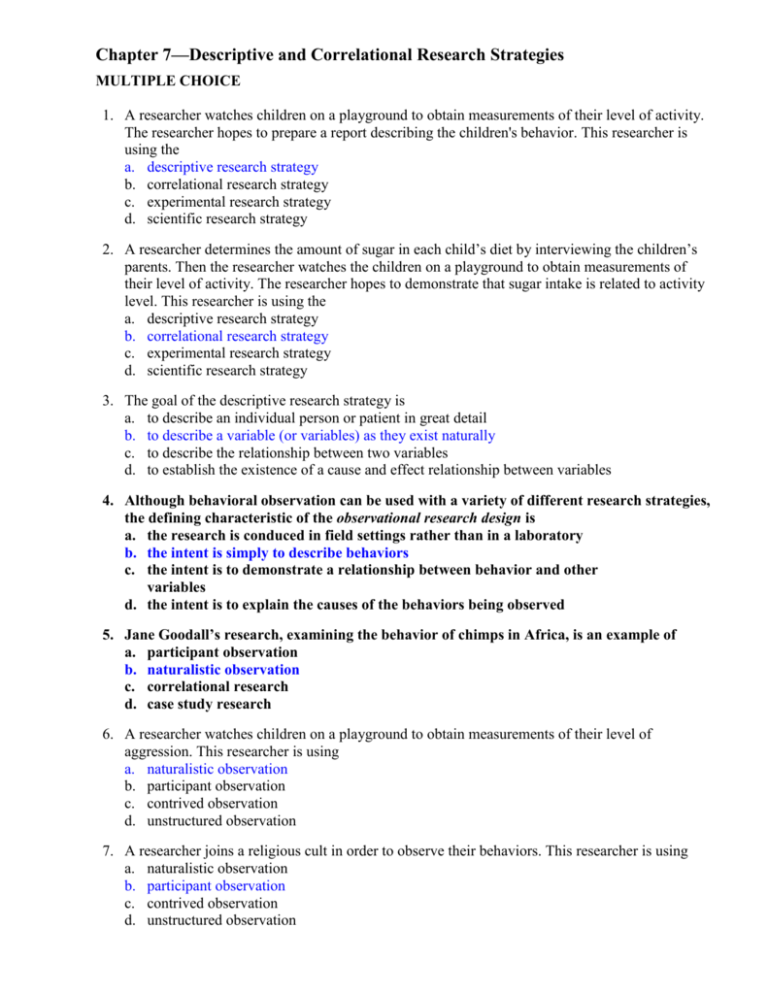
Chapter 7—Descriptive and Correlational Research Strategies MULTIPLE CHOICE 1. A researcher watches children on a playground to obtain measurements of their level of activity. The researcher hopes to prepare a report describing the children's behavior. This researcher is using the a. descriptive research strategy b. correlational research strategy c. experimental research strategy d. scientific research strategy 2. A researcher determines the amount of sugar in each child’s diet by interviewing the children’s parents. Then the researcher watches the children on a playground to obtain measurements of their level of activity. The researcher hopes to demonstrate that sugar intake is related to activity level. This researcher is using the a. descriptive research strategy b. correlational research strategy c. experimental research strategy d. scientific research strategy 3. The goal of the descriptive research strategy is a. to describe an individual person or patient in great detail b. to describe a variable (or variables) as they exist naturally c. to describe the relationship between two variables d. to establish the existence of a cause and effect relationship between variables 4. Although behavioral observation can be used with a variety of different research strategies, the defining characteristic of the observational research design is a. the research is conduced in field settings rather than in a laboratory b. the intent is simply to describe behaviors c. the intent is to demonstrate a relationship between behavior and other variables d. the intent is to explain the causes of the behaviors being observed 5. Jane Goodall’s research, examining the behavior of chimps in Africa, is an example of a. participant observation b. naturalistic observation c. correlational research d. case study research 6. A researcher watches children on a playground to obtain measurements of their level of aggression. This researcher is using a. naturalistic observation b. participant observation c. contrived observation d. unstructured observation 7. A researcher joins a religious cult in order to observe their behaviors. This researcher is using a. naturalistic observation b. participant observation c. contrived observation d. unstructured observation 8. Rosenham’s research investigating the experiences of mental patients and patient-staff interactions in psychiatric hospitals is an example of a. participant observation b. naturalistic observation c. correlational research d. case study research 9. The main advantage of contrived observation (compared with other types of observational research) is a. you can be more confident that the observed behaviors are natural b. there is less concern that the researcher is influencing the behaviors being observed c. it is more efficient because you do not have to wait for specific behaviors to occur d. it is less likely that the researcher will impose subjective interpretations on the data 10. Which observational research design has the greatest risk that the observer will influence the behaviors being observed a. naturalistic observation b. participant observation c. contrived observation d. non-participant observation 11. A limitation of participant observation is a. it is extremely time consuming b. there is a risk that the observer will influence the behaviors being observed c. there is a risk that the observer may become involved and lose objectivity d. the other three choices are all limitations 12. In general, observational research designs tend to have a. high internal validity and low external validity b. high internal validity and high external validity c. low internal validity and high external validity d. low internal validity and low external validity 13. Although surveys can be used with a variety of different research strategies, the defining characteristic of the survey research design is a. the research is conduced in field settings rather than in a laboratory b. the intent is simply to describe behaviors c. the intent is to demonstrate a relationship between behavior and other variables d. the intent is to explain the causes of the behaviors being surveyed 14. One problem with surveys administered by mail is a. you do not know exactly who completed the survey b. it is difficulty to maintain participant confidentiality c. a mailed survey can be inconvenient for participants d. a mailed survey can be threatening to participants 15. One problem with mail surveys is non-response bias. This means a. usually only a small percentage of the surveys are returned b. many questionnaires will be returned with missing answers c. individuals who return surveys may have different characteristics than those who don't return surveys d. attempts to increase the number of people who return the survey may produce a biased sample 16. Non-response bias is a problem associated primarily with surveys administered a. by mail b. by telephone c. in person to groups d. in person to individuals 18. Which of the following methods for administering a survey does not include the risk of interviewer bias? a. mail b. phone c. in person individual d. in person group 21. The multiple-personality study reported in Thigpen and Cleckley’s Three Faces of Eve is an example of a. participant observation b. naturalistic observation c. correlational research d. case study research 22. An advantage of the case study design (compared with group designs) is a. it can be used to study rare phenomena b. it can demonstrate a counterexample to a general principle c. it can be emotionally powerful and convincing d. the other three choices are all advantages of the case study design 23. In general, the case study design tends to have a. high internal validity and low external validity b. high internal validity and high external validity c. low internal validity and high external validity d. low internal validity and low external validity 24. The goal of correlational research is a. to describe an individual person or patient in great detail b. to describe a variable (or variables) as they exist naturally c. to describe the relationship between two variables d. to establish the existence of a cause and effect relationship between variables 26. Which research design is commonly used to help establish the reliability or validity of a measurement procedure? a. the observational research design b. the survey research design c. the case study design d. the correlational design 28. A researcher reports a inverse relationship between weight and exercise level for a group of 8-year-old children (greater weight is associated with less exercise). However, the researcher suspects that the children’s rate of metabolism may be responsible for the relationship. That is, children with higher metabolism exercise more and weigh less than children with lower metabolism. This is an example of a. the third-variable problem b. the directionality problem c. the reversal problem d. the criterion problem 29. In general, the correlational research strategy tends to have a. high internal validity and low external validity b. high internal validity and high external validity c. low internal validity and high external validity d. low internal validity and low external validity 30. A researcher reports a inverse relationship between weight and exercise level for a group of 8-year-old children (greater weight is associated with less exercise). However, the researcher cannot be sure whether the extra weight is preventing the children from exercising or whether the lack of exercise is leading to greater weight. This is an example of a. the third-variable problem b. the directionality problem c. the reversal problem d. the criterion problem Chapter 8—Experimental Research Strategy MULTIPLE CHOICE 1. The goal of the experimental research strategy is to establish the existence of a. a causal relationship between two variables b. a relationship between two variables c. no relationship between two variables d. a bi-directional relationship between two variables 2. The _______ research strategy is an approach to research that determines whether changes in one variable cause changes in the other. a. descriptive b. correlational c. experimental d. quasi-experimental 3. The purpose of manipulation in an experiment is to a. eliminate the directionality problem b. eliminate the third-variable problem c. establish a relationship between two variables d. establish a bi-directional relationship between two variables 4. Dr. Adams is interested in studying how type of food consumed can influence people's reaction times. A sample of 100 people is selected. Fifty people are assigned to the carbohydrate condition where Dr. Adams provides a carbohydrate meal for participants to consume. The other 50 people are provided with a protein meal. Following the meal, Dr. Adams measures reaction times for all participants. In this example, what are the treatment conditions? a. reaction times b. carbohydrate meal and protein meal c. carbohydrate meals d. protein meals 5. Dr. Adams is interested in studying how type of food consumed can influence people's reaction times. A sample of 100 people is selected. Fifty people are assigned to the carbohydrate condition where Dr. Adams provides a carbohydrate meal for participants to consume. The other 50 people are provided with a protein meal. Following the meal, Dr. Adams measures reaction times for all participants. In this example, how many levels of the independent variable are there? a. 100 b. 50 c. 2 d. 1 6. Dr. Adams is interested in studying how type of food consumed can influence people's reaction times. A sample of 100 people is selected. Fifty people are assigned to the carbohydrate condition where Dr. Adams provides a carbohydrate meal for participants to consume. The other 50 people are provided with a protein meal. Following the meal, Dr. Adams measures reaction times for all participants. In this example, how many independent variables are there? a. 100 b. 50 c. 2 d. 1 7. Dr. Jones is interested in studying how indoor lighting can influence people's moods during the winter. A sample of 100 households is selected. Fifty of the homes are randomly assigned to the bright-light condition where Dr. Jones replaces all the lights with 100-watt bulbs. In the other 50 houses, all the lights are changed to 60-watt bulbs. After two months, Dr. Jones measures the level of depression for the people living in the houses. In this example, the level of depression is the ________ variable. a. dependent b. extraneous c. correlational d. independent 8. Dr. Jones is interested in studying how indoor lighting can influence people's moods during the winter. A sample of 100 households is selected. Fifty of the homes are randomly assigned to the bright-light condition where Dr. Jones replaces all the lights with 100-watt bulbs. In the other 50 houses, all the lights are changed to 60-watt bulbs. After two months, Dr. Jones measures the level of depression for the people living in the houses. In this study, the independent variable is a. the brightness of the lights b. the level of depression c. the houses with 100-watt bulbs d. the houses with 60-watt bulbs 9. Dr. Jones is interested in studying how indoor lighting can influence people's moods during the winter. A sample of 100 households is selected. Fifty of the homes are randomly assigned to the bright-light condition where Dr. Jones replaces all the lights with 100-watt bulbs. In the other 50 houses, all the lights are changed to 60-watt bulbs. After two months, Dr. Jones measures the level of depression for the people living in the houses. In this example, how many dependent variables are there? a. 100 b. 50 c. 2 d. 1 10. Dr. Jones is interested in studying how indoor lighting can influence people's moods during the winter. A sample of 100 households is selected. Fifty of the homes are randomly assigned to the bright-light condition where Dr. Jones replaces all the lights with 100-watt bulbs. In the other 50 houses, all the lights are changed to 60-watt bulbs. After two months, Dr. Jones measures the level of depression for the people living in the houses. Assuming that the study uses people from different age groups, participant age would be a(n) __________ variable in the experiment. a. dependent b. independent c. extraneous d. confounding 11. Manipulating an independent variable involves a. exposing participants to at least one level of the independent variable b. exposing participants to at least two levels of the independent variable c. exposing participants to at least three levels of the independent variable d. measuring two or more behaviors and determining whether they are related 12. If a researcher were doing an experiment asking the question whether eating protein causes a sad mood, the mood following the protein feeding would be referred to as the ________ variable. a. independent b. dependent c. experimental d. controlled 14. In order to establish an unambiguous relationship between two variables, it is necessary to eliminate the possible influence of a. extraneous variables b. confounding variables c. independent variables d. dependent variables 15. A confounding variable is a variable that a. might influence the dependent variable because it varies systematically with the independent variable b. might influence the independent variable because it varies systematically with the dependent variable c. might influence the dependent variable and varies randomly with the independent variable d. might influence the independent variable and varies randomly with the dependent variable 16. An extraneous variable can be eliminated completely by a. holding it constant b. using randomization c. manipulating the independent variable d. measuring the dependent variable 17. Holding a variable constant can limit the ________ of an experiment. a. internal validity b. external validity c. reliability d. hypothesis 20. In an experiment, participants are usually assigned to treatments using random assignment. The reason for using random assignment is a. to allow the experimenter to manipulate participant variables b. to allow the experimenter to manipulate environmental variables c. to control for extraneous variables d. it is a required component of all experiments 21. A no-treatment control group is a condition in which participants a. receive a zero-value of the independent variable b. receive the treatment c. receive a fake treatment d. receive a non-zero value of the independent variable 22. Dr. Kim systematically varies the amount of caffeine in cola (0, 10, and 20 mg) and observes that his participants' anxiety levels increase. The 0-mg condition represents the a. experimental group b. placebo control group c. no-treatment control group d. waiting-list control group 23. A placebo control group is used to a. measure the effects of the independent variable b. examine the effects of no treatment c. separate the effects of the placebo from the real treatment effects d. assess how participants interpreted the manipulation 24. A researcher systematically varies people's stress levels to examine the effects of stress on performance. The researcher includes a measure of stress in order to a. measure the dependent variable b. measure extraneous variables c. control for confounding variables d. check the manipulation 26. A researcher moves the real world into the laboratory. This type of research is called a. a simulation study b. a field study c. a transported study d. a quasi-experimental study 27. A researcher moves an experiment out of the laboratory and into the real world. This type of research is called a. a simulation study b. a field study c. a transported study d. a quasi-experimental study 29. What is the advantage of a field study over a laboratory study? a. internal validity b. external validity c. reliability d. history 30. What is the advantage of a laboratory study over a field study? a. internal validity b. external validity c. reliability d. history Chapter 9—Quasi-Experimental Strategy and Developmental Designs MULTIPLE CHOICE 1. The basic threat to internal validity for a nonequivalent groups design is a. history b. assignment bias c. regression d. reactivity 3. The concept of nonequivalent groups means a. the researcher cannot control which people go into each group and cannot ensure that the groups are equivalent b. the two groups have completely different characteristics c. the researcher has randomly assigned people to groups so there is no guarantee that the groups are equal d. the number of participants is different from one group to another 4. A researcher introduces a new mathematics program in one school district and uses a neighboring district as a no-treatment control group. After the program is in place for 6 months, the researcher intends to give the students in both districts a standardized mathematics test and then compare their scores. This research cannot be classified as a true experiment because a. the treatment is administered to only one group b. there is no pretest to determine mathematics ability before the program c. the researcher does not control the assignment of participants to groups and therefore has a nonequivalent groups design d. it is not conducted in a laboratory 11. To evaluate the effectiveness of a treatment, a researcher selects participants who have extremely high depression scores. A week after treatment, the researcher notes a significant decrease in depression. Although the researcher would like to conclude that the treatment caused lower scores, this study is confounded by a. sensitization b. reactivity c. regression toward the mean d. ecological validity 23. A research study that evaluates developmental changes by examining different groups of individuals representing different ages, is called a. a time-series design b. an interrupted time-series design c. a cross-sectional design d. a longitudinal design 24. A researcher studies language development by selecting a sample of 2-year-old children, a sample of 3-year-old children, and a sample of 4-year-old children. Each child’s language skill is measured and the researcher plans to compare the scores for the three groups. This study is an example of a. a time-series design b. an interrupted time-series design c. a cross-sectional design d. a longitudinal design 26. The primary problem with a cross-sectional design is that differences between age groups may not be caused by age but rather are caused by a. history effects b. regression toward the mean c. cohort effects d. differential attrition 27. A researcher has studied the development of political attitudes for a group of college graduates by interviewing them at their class reunion every five years beginning in 1988. This research is an example of a. a time-series design b. an interrupted time-series design c. a cross-sectional design d. a longitudinal design 28. A research study that evaluates developmental changes by examining the same group of individuals at different times in their lives is called a. a time-series design b. an interrupted time-series design c. a cross-sectional design d. a longitudinal design 29. A researcher studies language development by selecting a sample of 2-year-old children and giving them a language skill test. Each year for the next two years, the children are brought back and tested again. The researcher plans to compare the children’s scores at age two, age three, and age four. This study is an example of a. a time-series design b. an interrupted time-series design c. a cross-sectional design d. a longitudinal design 30. A problem with a longitudinal design is that the results may be distorted by a. cohort effects b. participant attrition c. differential history effects d. assignment bias 31. A problem with longitudinal designs is that age is confounded with: a. cohort b. sex c. time of measurement d. group being studied Chapter 10—Experimental Designs: Between-Subjects Design MULTIPLE CHOICE 1. A design in which different participants are randomly assigned to the various treatment conditions in an experiment is a _______ design. a. single-subjects b. between-subjects c. within-subject d. matched groups 2. A between-subjects design differs from a within-subjects design in that in a between-subjects design a. only one group of participants is used b. only variables "between" the participants are examined c. at minimum two groups of participants are used d. each participant is exposed to each level of the independent variable 3. In a between-subjects design a. each participant receives one level of the independent variable b. all participants receive every level of the independent variable c. each participant is investigated in great detail with multiple measures d. behavioral observation is used 4. In an experiment on the effects of running on stress levels, one group of participants is tested after running on a treadmill for 30 minutes and another group of participants is tested after resting on a bed. This experiment is an example of a ________ design. a. single-subjects b. between-subjects c. within-subject d. matched groups 5. Which statement best characterizes a between-subjects experimental design? a. Participants are randomly selected from two different populations b. Participants are each assigned to one condition of the experiment c. Participants are each assigned to every condition of the experiment d. Participants with different characteristics make up the different conditions of the experiment 6. A random sample of sixty participants is obtained for an experiment. Half of the participants are assigned to treatment #1 and the other half are assigned to treatment #2. This experiment is an example of a _____ design. a. Between-subjects b. Within-subjects c. combined d. mixed Chapter 11—Experimental Designs: Within-Subjects Design MULTIPLE CHOICE 1. In a within-subjects research study, each participant is measured a. once b. once in each treatment condition c. twice in each treatment condition d. n! (n factorial) times, where n is the number of treatment conditions 2. A within-subjects design is also know as a(n) a. independent-measures design b. repeated-measures design c. equivalent groups design d. matched groups design 3. For a research study that compares problem solving ability for participants with three different levels of self-esteem (high self-esteem, medium self-esteem, and low self-esteem), what kind of design would be appropriate. a. between-subjects b. within-subjects c. matched subjects d. a combined, two-factor design 4. How many participants would be needed for a within-subjects experiment comparing four different treatment conditions with a total of 20 scores in each treatment. a. 20 b. 40 c. 80 d. cannot answer without more information 6. Within-subjects designs are most useful when a. individual differences are large and there are many participants available b. individual differences are large and there are relatively few participants available c. individual differences are small and there are many participants available d. individual differences are small and there are relatively few participants available 7. For an experiment that compares two treatment conditions with ten scores in each treatment, which design would require fewer subjects? a. between subjects b. within subjects c. matched subjects d. all would require the same number of subjects 8. An advantage of a within-subjects design as compared to a between-subjects design is a. it eliminates the threat that participant characteristics may become a confounding variable b. it reduces the variability by subtracting out the individual differences c. it usually requires fewer participants d. the other three choices are all advantages 9. The advantage of removing individual differences in a within-subjects design is a. it removes one source of potential confounding variables b. it reduces variability c. it can reveal treatment effects that might not be apparent otherwise d. the other three choices are all advantages 10. When an outside event occurs during a within-subject study so that measurements that are made afterward are influenced by the event, but measurements made before the event are not, the results are said to be confounded by a. history effects b. instrumentation c. maturation d. regression toward the mean 12. A researcher is conducting a within-subjects study that extends over a 5-day period and uses college students as participants. If there is a suicide at the college during the study that causes widespread depression among the students, then the internal validity of the study is threatened by a. history b. instrumentation c. maturation d. regression toward the mean 13. In a within-subjects study that extends over a relatively long time, it is possible that there will be systematic changes in the participants’ physiology or psychology that occur during the time of the study. If these changes influence the participants’ scores, causing scores at the end of the study to be different from scores at the beginning, the effect is called a. history effects b. instrumentation c. maturation d. regression toward the mean 14. A researcher evaluates the effectiveness of an art class by having an art expert judge the quality of student’s paintings at the beginning of the class, in the middle of the class, and at the end of the class. If the art expert’s standards for judgment change during the class, then the internal validity of the study is threatened by a. history b. instrumentation c. maturation d. regression toward the mean 15. The tendency for individuals who have extreme scores (high or low) on one measurement to have less extreme scores on a second measurement is called a. history effects b. instrumentation c. maturation d. regression toward the mean 16. When participation in one treatment condition has a lasting effect on individuals that influences their scores in future treatments, the study is confounded by a. history effects b. instrumentation c. carryover effects d. progressive error 17. For a within-subjects experiment, one of the primary threats to internal validity is a. individual differences that may exist within treatment conditions b. individual differences that may exist between treatment conditions c. the risk that one treatment condition may influence scores in other treatment conditions* d. the risk that one (or more) of the treatment conditions will have no influence on the participants' scores 21. The purpose for counterbalancing is a. to prevent subject variables from becoming confounding variables b. to prevent subject variables from adding to the error variance c. to prevent order effects from becoming a confounding variable d. to prevent order effects from adding to the error variance 22. An advantage of the between-subjects design versus the within-subjects design is that between-subjects a. generally requires fewer subjects b. usually is a more sensitive test (more likely to detect a treatment effect) c. eliminates the risk of order effects d. eliminates potential problems that may be caused by individual differences Chapter 12—Factorial Designs MULTIPLE CHOICE 1. What feature is required in a factorial design? a. more than one independent variable is manipulated b. more than two independent variables are manipulated c. only between-subject variables may be used d. only quasi-experimental variables may be used 2. How many independent variables are there in a two-factor design? a. 1 b. 2 c. 3 d. 4 3. How many independent variables are there in a 2 X 2 X 2 factorial design? a. 2 b. 3 c. 4 d. 8 4. In a 3 X 2 X 2 factorial design, how many levels of the third factor are there? a. 2 b. 3 c. 4 d. 8 5. How many conditions are there in a 2 X 2 X 2 factorial design? a. 2 b. 3 c. 4 d. 8 6. The reason to use a 2 X 2 factorial design rather than two separate experiments is to a. save time b. find an interaction between the independent variables c. find the main effects d. check the manipulation 7. In order to determine whether factors influence or interact with each other, a researcher must use a. two experiments b. a factorial design c. a between-subjects design d. a mixed design 8. In a matrix representing the structure of a factorial design, the differences between the overall column means define a. the main effect for one factor b. the interaction between the factors c. the main effect and the interaction between the factors d. nothing 9. In a factorial design, a main effect is the effect of a(n) ________ variable. a. independent b. dependent c. correlated d. extraneous 10. In a factorial design, a main effect is the a. only effect of interest b. effect of the interaction between two variables c. effect of one independent variable averaged over the levels of the other independent variable d. effect of one independent variable at one level of the other independent variable 11. How many main effects are there in a 2 X 2 X 2 factorial design? a. b. c. d. 2 3 4 8 12. In a 3 X 4 factorial design there are ________ main effect(s) and ________interaction(s) possible. a. 3; 4 b. 2; 3 c. 2; 1 d. 1; 2 13. For the following data, what numbers are compared to assess the main effect of factor A? a. b. c. d. A1 A2 B1 20 60 B2 30 70 25 65 30; 70 20; 30 60; 70 25; 65 14. In a factorial design, an interaction between the factors occur whenever a. the mean difference between the cells is not explained by the main effects b. the mean difference between the cells is explained by the main effects c. there is a the differences between the overall column means d. there is a the differences between the overall row means 15. The following data represent the means for each treatment condition in a two-factor experiment. Note that one mean is not given. Which of the following values would result in no main effect for factor B? a. b. c. d. 10 20 30 40 A1 A2 B1 20 40 B2 30 16. The following data represent the means for each treatment condition in a two-factor experiment. Note that one mean is not given. Which of the following values would result in no interaction? a. b. c. d. A1 A2 B1 20 40 B2 30 20 30 40 50 17. The following data represent the means for each treatment condition in a two-factor experiment. Note that one mean is not given. Which of the following values would result in no main effect for factor A? a. b. c. d. A1 A2 B1 20 60 B2 50 10 20 30 40 18. The following data represent the means for each treatment condition in a two-factor experiment. Note that one mean is not given. Which of the following values would result in no main effect for factor B? a. b. c. d. A1 A2 B1 20 60 B2 50 10 20 30 40 19. The following data represent the means for each treatment condition in a two-factor experiment. Note that one mean is not given. Which of the following values would result in no interaction between factors? a. b. c. d. A1 A2 B1 20 60 B2 50 60 70 80 90 20. An interaction occurs whenever a. the dependent variable is manipulated in a factorial design b. there is one main effect c. there are two main effects d. the effect of one independent variable depends on the level of the second independent variable 21. A clinician claims that the effectiveness of a new treatment varies depending on the gender of the client. Specifically, the new treatment has been shown to be very effective for females, but the treatment has little or no effect for males. In this example, a. there is an interaction between the treatment and client's gender b. there is no interaction between the treatment and client's gender c. there is no main effect of treatment d. there is no main effect of gender 22. A graph of a 2 X 2 factorial design demonstrates an interaction when the lines on the graph a. are parallel b. cross c. are steep in slope d. none of the other three choices demonstrate an interaction 23. Which of the following is possible to occur in a 2 X 2 factorial design? a. one main effect b. no main effects c. one interaction d. the other three choices are all possible to occur 24. Which of the following is possible to occur in a 2 X 2 factorial design? a. two main effects and two interactions b. no main effect for one factor, one main effect for the other factor, and two significant interactions c. no main effect for either factor and one interaction d. the other three choices are all possible to occur Chapter 14—Statistical Evaluation of Data MULTIPLE CHOICE 14. The data for a correlation are often displayed in a graph called a a. histogram b. polygon c. line graph d. scatterplot 15. The data for a correlation are displayed in a graph and show a set of points tightly clustered around a line sloping up to the right. Which of the following is the best estimate for the correlation. a. +.10 b. +.90 c. - .10 d. - .90 16. If the data in a scatterplot form a nearly perfect circle, the Pearson correlation would be approximately a. +0.8 or +0.9 b. -0.8 or -0.9 c. 1.00 d. zero TRUE/FALSE 8. A negative correlation means that as the X values decrease, the Y values also tend to decrease. 9. The value for a correlation can never be greater than 1.00. 10. A correlation of -0.90 indicates a stronger relationship– than a correlation of +0.50.



